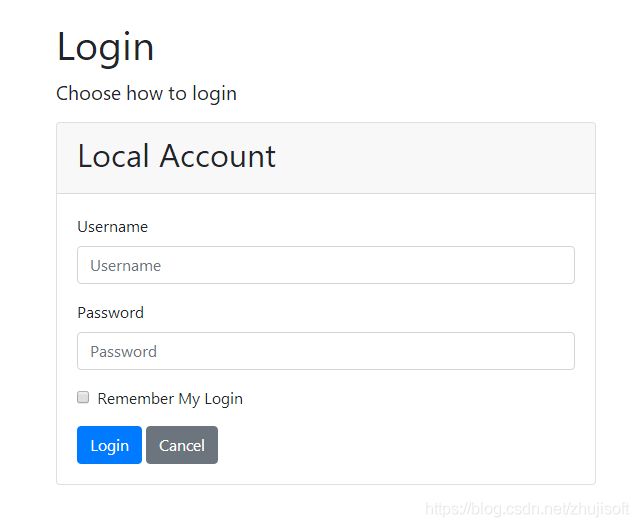IdentityServer4 (IDS4) UI界面使用
在本快速入门中,将对通过OpenID Connect协议进行的交互式用户身份验证的支持添加到上一章中构建的IdentityServer中。
实现后,我们将创建一个将使用IdentityServer进行身份验证的MVC应用程序。
本文假设已创建《IdentityServer4 (IDS4) 快速入门》一文中的IdentityServer服务项目,将修改部分配置以支持带UI的MVC客户端。
系统环境与上文相同。
一、添加UI
从QuickStart\src\IdentitySever目录,运行以下命令。
dotnet new is4ui运行此命令后将在IdentityServer项目中增加支持UI模版, 添加MVC UI后,还需要在DI系统和管道中启用MVC。当您查看时,Startup.cs您会在ConfigureServices和Configure方法中找到注释,这些注释告诉您如何启用MVC。
你可以在IdentityServer项目中看到新增了wwwroot、Views目录和一些支持文件。
二、创建一个MVC客户端
从QuickStart\src目录下,运行以下命令。
dotnet new mvc -n MvcClient
cd ..
dotnet sln add .\src\MvcClient\MvcClient.csproj添加依赖包,在src\MvcClient目录下运行
dotnet add package Microsoft.AspNetCore.Authentication.OpenIdConnect打开MvcClient项目,在startup.cs文件中添加代码,修改完成后如下:
using System;
using System.Collections.Generic;
using System.Linq;
using System.Threading.Tasks;
using Microsoft.AspNetCore.Builder;
using Microsoft.AspNetCore.Hosting;
using Microsoft.AspNetCore.HttpsPolicy;
using Microsoft.Extensions.Configuration;
using Microsoft.Extensions.DependencyInjection;
using Microsoft.Extensions.Hosting;
using System.IdentityModel.Tokens.Jwt;
namespace MvcClient
{
public class Startup
{
public Startup(IConfiguration configuration)
{
Configuration = configuration;
}
public IConfiguration Configuration { get; }
// This method gets called by the runtime. Use this method to add services to the container.
public void ConfigureServices(IServiceCollection services)
{
services.AddControllersWithViews();
JwtSecurityTokenHandler.DefaultMapInboundClaims = false;
services.AddAuthentication(options =>
{
options.DefaultScheme = "Cookies";
options.DefaultChallengeScheme = "oidc";
})
.AddCookie("Cookies")
.AddOpenIdConnect("oidc", options =>
{
options.Authority = "https://localhost:5001";
options.ClientId = "mvc";
options.ClientSecret = "secret";
options.ResponseType = "code";
options.SaveTokens = true;
});
}
// This method gets called by the runtime. Use this method to configure the HTTP request pipeline.
public void Configure(IApplicationBuilder app, IWebHostEnvironment env)
{
if (env.IsDevelopment())
{
app.UseDeveloperExceptionPage();
}
else
{
app.UseExceptionHandler("/Home/Error");
// The default HSTS value is 30 days. You may want to change this for production scenarios, see https://aka.ms/aspnetcore-hsts.
app.UseHsts();
}
app.UseHttpsRedirection();
/*
app.UseStaticFiles();
app.UseRouting();
app.UseAuthorization();
app.UseEndpoints(endpoints =>
{
endpoints.MapControllerRoute(
name: "default",
pattern: "{controller=Home}/{action=Index}/{id?}");
});
*/
app.UseStaticFiles();
app.UseRouting();
app.UseAuthentication();
app.UseAuthorization();
app.UseEndpoints(endpoints =>
{
endpoints.MapDefaultControllerRoute()
.RequireAuthorization();
});
}
}
}
AddAuthentication 将身份验证服务添加到依赖注入DI。
使用一个Cookie在本地登录的用户(通过"Cookies"为DefaultScheme),和设定的DefaultChallengeScheme到oidc,因为当我们需要用户登录,我们将使用ID连接协议。
然后AddCookie,我们使用添加可以处理cookie的处理程序。
最后,AddOpenIdConnect用于配置执行OpenID Connect协议的处理程序。该Authority指示了信任令牌服务所在。然后,我们通过ClientId和标识此客户ClientSecret。 SaveTokens用于将来自IdentityServer的令牌保留在cookie中
还需要修改Views\Home\index.cshtml主视图以显示用户的声明以及cookie属性:
@using Microsoft.AspNetCore.Authentication
Claims
@foreach (var claim in User.Claims)
{
- @claim.Type
- @claim.Value
}
Properties
@foreach (var prop in (await Context.AuthenticateAsync()).Properties.Items)
{
- @prop.Key
- @prop.Value
}
三、修改IdentityServer服务端
1、添加对OpenID Connect Identity Scope的支持
修改config.cs文件,通过修改以下属性来添加对标准openid(主题ID)和profile(名字,姓氏等)范围的支持:
public static IEnumerable IdentityResources =>
new IdentityResource[]
{
new IdentityResources.OpenId(),
new IdentityResources.Profile(),
}; 在startup.cs文件ConfigureServices中位置向IdentityServer注册身份资源:
var builder = services.AddIdentityServer(options =>
{
// see https://identityserver4.readthedocs.io/en/latest/topics/resources.html
options.EmitStaticAudienceClaim = true;
})
.AddInMemoryIdentityResources(Config.IdentityResources)
.AddInMemoryApiScopes(Config.ApiScopes)
.AddInMemoryClients(Config.Clients);
2、添加测试用户
示例UI还带有一个内存中的“用户数据库”。可以通过添加AddTestUsers扩展方法在IdentityServer中启用它:
var builder = services.AddIdentityServer(options =>
{
// see https://identityserver4.readthedocs.io/en/latest/topics/resources.html
options.EmitStaticAudienceClaim = true;
})
.AddInMemoryIdentityResources(Config.IdentityResources)
.AddInMemoryApiScopes(Config.ApiScopes)
.AddInMemoryClients(Config.Clients)
.AddTestUsers(TestUsers.Users);3、将MVC客户端添加到IdentityServer配置
修改config.cs文件,客户端列表应如下所示:
public static IEnumerable Clients =>
new List
{
// machine to machine client (from quickstart 1)
new Client
{
ClientId = "client",
ClientSecrets = { new Secret("secret".Sha256()) },
AllowedGrantTypes = GrantTypes.ClientCredentials,
// scopes that client has access to
AllowedScopes = { "api1" }
},
// interactive ASP.NET Core MVC client
new Client
{
ClientId = "mvc",
ClientSecrets = { new Secret("secret".Sha256()) },
AllowedGrantTypes = GrantTypes.Code,
// where to redirect to after login
RedirectUris = { "https://localhost:5002/signin-oidc" },
// where to redirect to after logout
PostLogoutRedirectUris = { "https://localhost:5002/signout-callback-oidc" },
AllowedScopes = new List
{
IdentityServerConstants.StandardScopes.OpenId,
IdentityServerConstants.StandardScopes.Profile
}
}
}; 四、测试运行
修改MvcClient项目launchSettings.json文件,将运行端口设为5002(5001已被IdentityServer占用)
"MvcClient": {
"commandName": "Project",
"dotnetRunMessages": "true",
"launchBrowser": true,
"applicationUrl": "https://localhost:5002",
"environmentVariables": {
"ASPNETCORE_ENVIRONMENT": "Development"
}
}先运行IdentityServer项目,然后运行MvcClient,再访问 https://localhost:5002
输入TestUsers中的用户名和密码 ,则可以看到从IdentityServer中取得的token。
五、其他实验测试
六、参考文章
https://identityserver4.readthedocs.io/en/latest/quickstarts/2_interactive_aspnetcore.html


